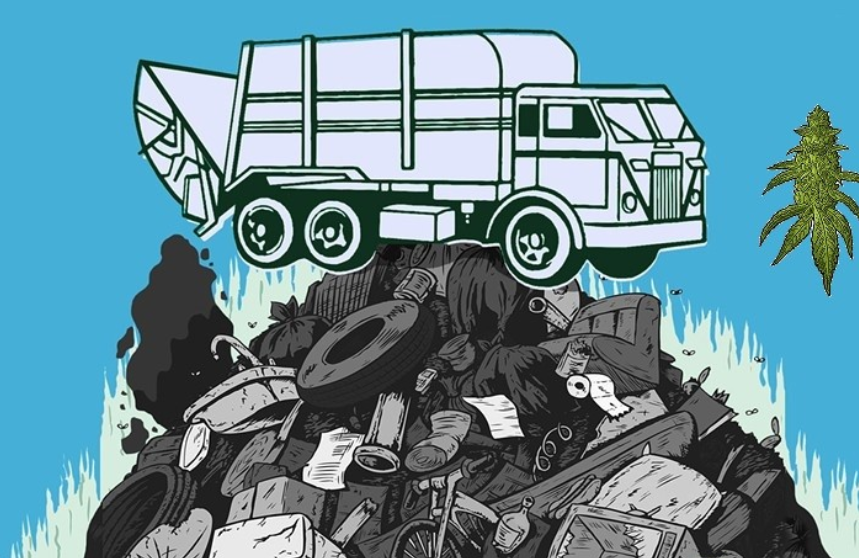The Cannabis Industry Produces Tons of Waste
Like any agricultural activity, the cannabis industry generates a significant amount of solid waste. In today’s consumer-driven society, and as with all retail sectors, the cannabis industry creates packaging materials that ultimately end up in landfills. However, due to uniquely strict regulations applied to cannabis, the industry ends up producing much more waste than similar sectors.
Let’s start with “green waste” generated during cultivation: stems and roots, as well as “sick,” spoiled, or damaged plants. Add to that the solvents and gases used to make cannabis extracts. Then consider the tons of child-resistant plastic packaging required for finished products and ready-to-sell cannabis. Just imagine the scale of this waste!
A few years ago, Seattle’s alternative newspaper The Stranger reported that Washington State produced 800 tons of cannabis waste from 2014 to 2017. The legal cannabis industry in Washington has grown by more than 50% since 2017, as has the amount of waste.
Taking the Problem Seriously
Some states are working to address this issue. In California, which is expected to account for nearly a quarter of U.S. cannabis sales growth by 2024, three different state agencies have their own sets of regulations and requirements for managing cannabis waste. These rules tend to increase the amount of waste! They even contradict Senate Bill 1383, signed by Governor Jerry Brown in 2016, which requires the state to reduce organic waste by 50% from 2014 levels by 2020 and by 75% by 2025.
Massachusetts has issued “guidance” for cannabis companies in the state, outlining requirements for managing their waste. Similar guidelines have been launched in other states, such as Oregon, Washington, and Colorado.
The “Mix Waste with Other Waste” Rule
The “50-50 rule” can actually double the amount of trash. Environmental officials in Colorado don’t yet have data on the amount of solid cannabis waste generated annually in the state, but they believe cannabis plant waste is the biggest problem.
“We have a ‘50-50’ mixed waste rule, which means all cannabis waste must be mixed with 50% non-cannabis waste before it leaves the facility for disposal,” says Kaitlin Urso, an environmental consultant with the Colorado Department of Public Health and Environment. “This rule,” Urso explains, “is intended to prevent cannabis waste, which may contain some THC, from entering the illegal market. But it creates huge challenges for cannabis companies. Some Colorado cannabis businesses try to create their own ‘50-50’ mix by adding shredded cardboard or even mineral wool to their green cannabis waste.”
Making Waste “Unrecognizable”
The “50-50” rule adds a new level of complexity and cost for Colorado cannabis companies. “For example, in Denver, you have to make your cannabis waste ‘unusable and unrecognizable,’” says Amy Andrle, owner of L’Eagle Services, a licensed adult-use cannabis company that operates several greenhouses and retail stores in Denver. “We store compostable waste in a secure room under camera surveillance until we hand it over to a waste disposal service.” According to Amy, composting can be quite expensive, since disposal fees are charged by weight.
Competition in Cannabis Waste Recycling
The American waste management industry, worth several billion dollars, has taken notice of the solid waste problems in the cannabis sector. According to waste management experts, all organic waste from cannabis production can be disposed of using four different methods: incineration, landfill, composting, and anaerobic digestion. The latter involves microorganisms breaking down biodegradable materials, such as cannabis waste, in the complete absence of oxygen. This process creates methane, a gas that can be used as fuel, as well as CO2 and other byproducts.
GFL Environmental, an environmental services company, says its Colorado waste management division currently serves 120 cannabis industry clients. “Proportionally, it’s a small amount, but environmental responsibility is very important to us!” a Leafly representative said in an email. “We even created a separate ‘cannabis’ code in our database to track the amount of recycling and composting our clients do. Some of these clients like to know how successfully they recycle waste compared to their industry competitors.”
There are small signs of progress. The cannabis industry is striving to reduce solid waste streams and make its business cleaner.
Colorado
Starting in January 2020, Colorado plans to launch a return program for cannabis packaging, vape cartridges, and other plastics. According to Kaitlin Urso, the voluntary program will allow dispensaries to sterilize and relabel these items for reuse. Urso says the idea for this program came from Colorado cannabis companies themselves, who are helping to shape state cannabis regulations.
She notes that in 2014, the first year of legal adult-use cannabis sales in Colorado, “There was a lot of fear and a lot of unknowns. So I think the caution was that when all the regulations were released, they were focused on safety, security, and reducing the black market. Environmental issues really weren’t considered at that time.” But now, she says, “With a legal market that’s been around for five years, we have good compliance and a solid management system. It’s really a great time to create a more logical regulatory environment.”
Canada Tries to Reduce Waste
Managing cannabis industry waste has truly become an international issue. In Canada, which just celebrated the first anniversary of national cannabis legalization, there are calls to help reduce the amount of solid waste created by cannabis products.
“To reduce the amount of waste created by product packaging, the rules allow for reusable wrappers and flip-top labels, as well as flexible packaging materials like cardboard,” the Canadian federal government recently noted in a report. “Health Canada encourages the use of innovative and environmentally friendly packaging approaches, provided requirements and regulations are met.”
Consumers Can Recycle Cannabis Waste Too
Consumers can also contribute to recycling cannabis packaging. “They need to learn what can and can’t be recycled,” says Urso. As for the industry itself, “The best thing it can do is be open to learning,” she adds. “This is an evolving market, so it needs to be open to solutions.”



